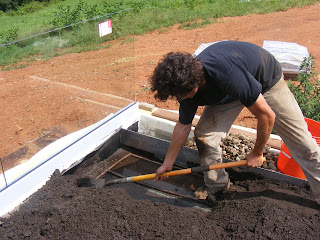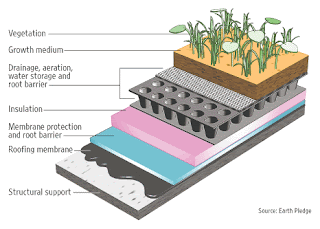


Green roofs are known to retain 50-60 percent of the total annual runoff volume of a roof. Most importantly, the soil retains 90-100% of the critical first hour of heavy rainfall that can overwhelm storm water management systems.

Acting as natural bio-filtration devices, green roofs help reduce water contamination and help trap and filter pollutants from entering our storm water, thereby allowing cleaner water to enter our water basins.
Reduce the effects of ‘urban heat Island effect’
Covering dark conventional roofs with green roofs can significantly reduce the temperature above the roof and in the heat of the summer, the temperature on green roofs can be significantly cooler than conventional roofing anywhere from 20 to 60 degrees cooler.
Control building temperature
For hundreds of years, living roofs were used in various countries to prevent heat from escaping or penetrating during different seasons. Controlling a building’s interior is possible by replacing the asphalt surface of the roof with plants and soil, which act as insulators to keep buildings cooler in summer and warmer in winter.

Provide soothing and calming spaces to look down upon
With improvements being made in every aspect of green roof technology, we should see more green roofs offering a greater diversity of plants as well as more human access. Either way green roofs are more aesthetically pleasing, giving the viewer a soothing vista to gaze upon.


Create wildlife corridors for migrating species
Green roofs can be used to create wildlife habitats to supplement or replace diminishing open space in developing areas. Many migrating species pass through urban centers and green roofs can offer these creatures the food, shelter, and respite they need to successfully finish their journey.
The costs of going green
Long-term financial benefits
Green roofs will lower the cost of storm water management in urban areas. Once a green roof is in full operation, it should cut down on the amount of heating and air conditioning a building needs to maintain comfortable temperatures. These reductions should be seen in the monthly costs of electricity and natural gas.
Other Economic Benefits of green roof
- Potential to reduce the size of HVAC equipment on new or retrofitted buildings (capital and operational savings).
- Potential to reduce the amount of standard insulation used.
- Potential to incorporate cooling and/or water treatment functions.
- Potential to reduce or eliminate roof drains.
- Potential to meet regulatory requirements for stormwater management.
- Provision of amenity space for day care, meetings, and recreation;
- Aesthetic appeal, increasing the value of the property and the marketability of the building as a whole, particularly for accessible green roofs. For example, American and British studies show that “good tree cover” adds between 6 to 15 per cent to the value of a home. Green roofs offer the same visual and environmental benefits.

Savings for the Homeowner
The average green roof lasts for an average of 40 years as opposed to the 17-year life expectancy of roofs installed with standard roofing materials, like cedar shake. Living roofs come with lower maintenance, repair and replacement expenditures than “dead” roofs. A reduction should also be noted in waste water charges.
What makes up a green roof?

A green roof starts with a waterproofing layer. For existing roofs, the existing waterproofing (asphalt shingles, tar and gravel, etc.) can be used. For new construction, a single-ply membrane such as EPDM (ethylene propylene diene monomer – a rubber typically used for pond liners) or TPO (thermoplastic polyolefin – an environmentally friendly and recyclable roofing product mostly used in large-scale commercial buildings, like the Rogers Centre) is usually used. EPDM and TPO are quick to install, and also act as a root repellent, preventing plant roots from compromising the waterproofing.
On top of the waterproofing layer is a drainage, water retention and filter layers. These layers also act as root barriers. More importantly, they help manage the amount of water that is retained on the roof and ensure that the growing medium doesn’t clog the drainage layer and wash away.

